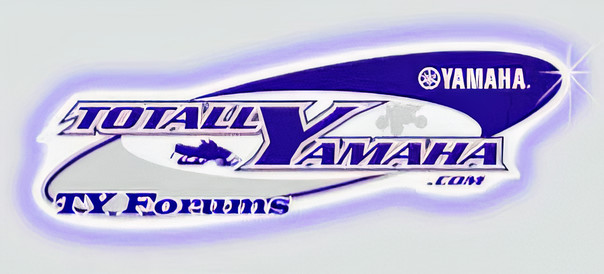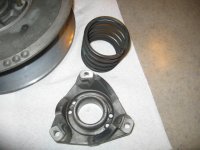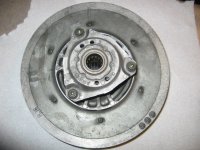97 sx700 Sled was turning 9100 rpms I know nothing about clutches so took it to the local shop and here is what i have now. 8700 rpms at wot. Primary has 17.2 inner hole outer hole has 13.9 New yamaha belt 89L. Also they moved the secondary spring down 3 notches. They said everything in the clutches look good no bad parts. What else can I do to get rpms down some.
The sled is stock. The only thing done to it was the head gasket mod.
The sled is stock. The only thing done to it was the head gasket mod.
Last edited:
FJViper
New member
Need some more info. What exactly did the shop set your secondary to? If they moved it down 3 notches what is it at 50? 60? Belt for your sled should be a 8CH not the 89L. May just be a matter of adding some more tip weight. Are you 100% sure that everything else is stock?There are alot of other people on here who know alot more about clutching than I do...someone will chime in> Just be ready for some questions.
Went and looked at clutches white and silver spring on primary. Secondary spring is black with a small green stripe. Its in 0 and cant tell what other hole its at 10 20 or 30 degree wrap. I am guessing 10
What fly weights do you have in it?...should be 8ch at 42-43 grams. sec wrap at 60* ( 3-3). The 89-l Belt will work fine! If all else is stock ,,try a smaller roller in the primary, like a 14.5 mm
Last edited:
I don't know what fly wieghts are in it. I assume they are stock. What is the roller and what does it do and are they easy to change.
the rollers are what the flyweights roll up against as the clutch closes, a smaller roller = lower shift out. easy to change. do not assume everything is stock when asking for help on a particular problem...find out what you have so we know how to help, otherwise its pointless to ask! we don't want to lead you down the wrong trail, there could be countless things that it could be...start out by finding out what you have in there . Its gonna take a little work.
Last edited:
Yammy you are 100 percent correct I am sorry.
Ok here is what I can tell you for sure fly wieghts said 00 8ch on them. Rivets say nothing on them. But the shop told me 13.9 outer and 17.2 inner. The one closes to the tip of the fly wieght looks smaller to me. Rollers I have no idea could not find any writing or markings on them. The spring looked white and silver when it was in the clutch. Out of the clutch it just looks black to me. Cant find any markings or numbers on it. The secondary spring is black with a green dot to say. It is in 0 and 2 So that would be 20 degrees.
Ok here is what I can tell you for sure fly wieghts said 00 8ch on them. Rivets say nothing on them. But the shop told me 13.9 outer and 17.2 inner. The one closes to the tip of the fly wieght looks smaller to me. Rollers I have no idea could not find any writing or markings on them. The spring looked white and silver when it was in the clutch. Out of the clutch it just looks black to me. Cant find any markings or numbers on it. The secondary spring is black with a green dot to say. It is in 0 and 2 So that would be 20 degrees.
ok 20 * will not work well, you need to put it at 60 or 70 *....3-3 or 6-1 for holes . try that and see if it don't bring the r's down
FJViper
New member
Sounds like the shop just tried to band-aid the over-rev issue by setting the wrap super low. 20*? Are you kidding me??!! yammy's right, should be a 60-70.
well atleast I have you guys to help me. Thanks
I went for a small ride today after putting the clutches back together and cleaning them some since they where apart. Lets say I've had better days
I will try it when I get the sled put back together. Now I need a few parts. Caught some ice today and to make a long story short ended up rolling it.
I went for a small ride today after putting the clutches back together and cleaning them some since they where apart. Lets say I've had better days
I will try it when I get the sled put back together. Now I need a few parts. Caught some ice today and to make a long story short ended up rolling it.

Last edited:
FJViper
New member
Holy crap!! Hope you came out of it alright.
Backwoods M Max
New member
You might be reading the setting on the secondary wrong, 8700 is right at the high end of the tolerance for wot on a red head with a stock pipe. 8500-8700 is spot on for a red head.
Take a picture of the secondary and post it.
Right from the tech manual. If you have 8CH weights those rivets are correct for a sx at sea level. Target rpm is 8500 with a +/- 200 tolerance. On a brand new belt that is not broken in and I'm sure giving you a little slip on the top end I wouldn't be worried.
Take a picture of the secondary and post it.
Right from the tech manual. If you have 8CH weights those rivets are correct for a sx at sea level. Target rpm is 8500 with a +/- 200 tolerance. On a brand new belt that is not broken in and I'm sure giving you a little slip on the top end I wouldn't be worried.
I thought 8300 was the target rpm and 8200 to 8400 was the range. Due to what the tech pages say here. Maybe I miss understood. Iowa is 1100 feet above sea level. So should I have the std. rivets 13.3 inner and 10.3 outer Theoretically
Well I have most of my parts now. Hoping to have it ridable by Friday. I will also set the secondary to 60 degrees and let you guys know. As far a the role over I came out fine a few bumps and bruises.
Well I have most of my parts now. Hoping to have it ridable by Friday. I will also set the secondary to 60 degrees and let you guys know. As far a the role over I came out fine a few bumps and bruises.
Last edited:
Backwoods M Max
New member
When I get home and have the internet again (my air card died and I'm on a tug boat) I will post the set up pages for you. Without knowing what your weights are, guessing what rivets are in there is just a guess. I gave you sea level setup for a vMax, because the sx, and sx-r (blue sleds) didn't come out until 2000. So I am almost willing to bet money they set up your clutch based on that. If it does have 8ch weights that's exactly why they did it. They are going to tune that sled for what it has for parts, not what it says on the hood. What helix do you have? Can you snap a pic of it and post it, along with the spring hole? You may have a non stock helix in there from the previous owner and that was the best they could do to make it ride right.
As far as roller, there are no part numbers on them, you can easily pull the cover on the primary and measure one with a set of calipers. There are no part numbers on there. Try and give the clutch setup guys a little credit. They do it more often than we all do, and unless he told you that he didn't test the setup give him the benefit out the doubt that he took it up and ran it pinned down a trail to make sure it was in the ballpark.
Go over to Tom Hartman's website and read his page on clutching. It is the best condensed free reading on clutching you will find. I spent a lot of time talking to him over the fall getting my mountain max set up right after it had been set up to trail ride by the previous owner. We changed springs for lower engagement and better back shift. I pulled a weight to weigh it and get a total weight, 48g. I have wanted to get the sled back to stock now that it has a longer track on it to make sure it's running the way it should before tweaking it. The clutch shop had swapped the rivets so they were in the opposite holes, I FREAKED out and though it was the end of the world. Tom said it's fine, as long as total weight is the same. Just go ride it then come back and tell me how it was he said.
I will leave you with this, as he left me: (basic fundamentals) primary spring controls engagement, weight profile and rivets controls up shift, spring wrap and helix angle controls back shift. If you want to work the top end rpm change the tip rivet. If you want to adjust mid range loading change the middle rivet, but it will alter total weight. Helix tension can do a little fine tuning, but for the most part helix angle controls when shift occurs during engine loading.
With that, my fingers hurt and my phone is dead. I will try to get the charts up for you Thursday morning when I'm enjoying my first of 14 Saturday mornings in a row at home.
As far as roller, there are no part numbers on them, you can easily pull the cover on the primary and measure one with a set of calipers. There are no part numbers on there. Try and give the clutch setup guys a little credit. They do it more often than we all do, and unless he told you that he didn't test the setup give him the benefit out the doubt that he took it up and ran it pinned down a trail to make sure it was in the ballpark.
Go over to Tom Hartman's website and read his page on clutching. It is the best condensed free reading on clutching you will find. I spent a lot of time talking to him over the fall getting my mountain max set up right after it had been set up to trail ride by the previous owner. We changed springs for lower engagement and better back shift. I pulled a weight to weigh it and get a total weight, 48g. I have wanted to get the sled back to stock now that it has a longer track on it to make sure it's running the way it should before tweaking it. The clutch shop had swapped the rivets so they were in the opposite holes, I FREAKED out and though it was the end of the world. Tom said it's fine, as long as total weight is the same. Just go ride it then come back and tell me how it was he said.
I will leave you with this, as he left me: (basic fundamentals) primary spring controls engagement, weight profile and rivets controls up shift, spring wrap and helix angle controls back shift. If you want to work the top end rpm change the tip rivet. If you want to adjust mid range loading change the middle rivet, but it will alter total weight. Helix tension can do a little fine tuning, but for the most part helix angle controls when shift occurs during engine loading.
With that, my fingers hurt and my phone is dead. I will try to get the charts up for you Thursday morning when I'm enjoying my first of 14 Saturday mornings in a row at home.
Backwoods M Max
New member
http://www.totallyamaha.net/forums/threads/95706-SXR-700-what-is-it
Post #9
Now that you mention that I remember that the SxR were only made in 2000/2001. Its has a 1998 manufacture date making it a 1999 model. Sled has ZERO decals on it, I would guess a SX Vmax.
Rivets are most likely correct for those weights, given the setup chart like I mentioned before.
Post #9
Now that you mention that I remember that the SxR were only made in 2000/2001. Its has a 1998 manufacture date making it a 1999 model. Sled has ZERO decals on it, I would guess a SX Vmax.
Rivets are most likely correct for those weights, given the setup chart like I mentioned before.
Vmaxin
New member
Put the right belt on for starters. Use a Carlisle ultimax or a yamaha 8dn belt.
Have not got to test ride it today been snowing and blowing here all day. Hoping to ride tommorrow.
I am not sure why every ones says the 89L is the wrong belt. Look it up on yamaha parts house.com. The tech pages here call for an 8ch
Item 27 Belt8CH-17641-00-00 89L-17641-01-00 Well 8ch has a line through it so I am guessing they do not make it any more. I have a Carlisle belt sitting here has 50 miles on it. It turns more rpms with that belt then with the 89L. It is my understanding that the 8dn will produce more rpms because it is a harder compound. Also it had an 89L on it when I bought the sled.
I am not sure why every ones says the 89L is the wrong belt. Look it up on yamaha parts house.com. The tech pages here call for an 8ch
Item 27 Belt8CH-17641-00-00 89L-17641-01-00 Well 8ch has a line through it so I am guessing they do not make it any more. I have a Carlisle belt sitting here has 50 miles on it. It turns more rpms with that belt then with the 89L. It is my understanding that the 8dn will produce more rpms because it is a harder compound. Also it had an 89L on it when I bought the sled.
Last edited:
Took the sled out today it is running well and riding fine. The rpms on the trail where 8500 to 8700 at wot.
Because most everyone does not understand, They have been told that's the belt to run so that's the belt to run... The 97 runs an 8ch belt or an 89-L,the 8ch is a discontinued belt so most went to the 89-l belt ,until the 8dn came out ,but on the older 97's the clutching is a lil diferent so you have to re adjust it, if you want to run the 8dn, you have to put heavier rivets in the flyweights or you are goin to over rev the motor!Have not got to test ride it today been snowing and blowing here all day. Hoping to ride tommorrow.
I am not sure why every ones says the 89L is the wrong belt. Look it up on yamaha parts house.com. The tech pages here call for an 8ch
Item 27 Belt8CH-17641-00-00 89L-17641-01-00 Well 8ch has a line through it so I am guessing they do not make it any more. I have a Carlisle belt sitting here has 50 miles on it. It turns more rpms with that belt then with the 89L. It is my understanding that the 8dn will produce more rpms because it is a harder compound. Also it had an 89L on it when I bought the sled.


